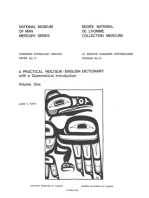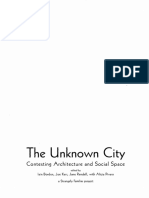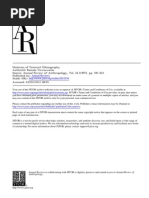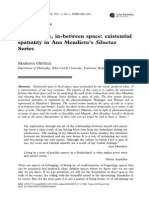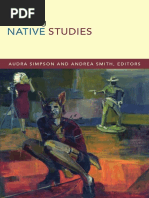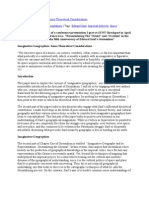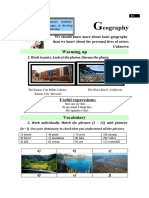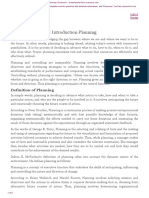0 ratings0% found this document useful (0 votes)
735 viewsSyllabus Ethnography of Space and Place
Syllabus Ethnography of Space and Place
Uploaded by
Veronica TapiaThis document provides the syllabus for an ethnography of space and place course. The course will use anthropological tools like participant observation, interviews, and behavioral mapping to study spaces in modern cities. Students will complete a book review, fieldwork project, and final paper applying course theories. Topics include spatializing culture, embodied space, the social construction and production of space, and the privatization of public space. Required readings include The Anthropology of Space and Place and On the Plaza, as well as an ethnography selected by each student. Course requirements include weekly discussions, presentations, and a final paper applying theories from the course to the student's fieldwork project.
Copyright:
© All Rights Reserved
Available Formats
Download as PDF, TXT or read online from Scribd
Syllabus Ethnography of Space and Place
Syllabus Ethnography of Space and Place
Uploaded by
Veronica Tapia0 ratings0% found this document useful (0 votes)
735 views12 pagesThis document provides the syllabus for an ethnography of space and place course. The course will use anthropological tools like participant observation, interviews, and behavioral mapping to study spaces in modern cities. Students will complete a book review, fieldwork project, and final paper applying course theories. Topics include spatializing culture, embodied space, the social construction and production of space, and the privatization of public space. Required readings include The Anthropology of Space and Place and On the Plaza, as well as an ethnography selected by each student. Course requirements include weekly discussions, presentations, and a final paper applying theories from the course to the student's fieldwork project.
Copyright
© © All Rights Reserved
Available Formats
PDF, TXT or read online from Scribd
Share this document
Did you find this document useful?
Is this content inappropriate?
This document provides the syllabus for an ethnography of space and place course. The course will use anthropological tools like participant observation, interviews, and behavioral mapping to study spaces in modern cities. Students will complete a book review, fieldwork project, and final paper applying course theories. Topics include spatializing culture, embodied space, the social construction and production of space, and the privatization of public space. Required readings include The Anthropology of Space and Place and On the Plaza, as well as an ethnography selected by each student. Course requirements include weekly discussions, presentations, and a final paper applying theories from the course to the student's fieldwork project.
Copyright:
© All Rights Reserved
Available Formats
Download as PDF, TXT or read online from Scribd
Download as pdf or txt
0 ratings0% found this document useful (0 votes)
735 views12 pagesSyllabus Ethnography of Space and Place
Syllabus Ethnography of Space and Place
Uploaded by
Veronica TapiaThis document provides the syllabus for an ethnography of space and place course. The course will use anthropological tools like participant observation, interviews, and behavioral mapping to study spaces in modern cities. Students will complete a book review, fieldwork project, and final paper applying course theories. Topics include spatializing culture, embodied space, the social construction and production of space, and the privatization of public space. Required readings include The Anthropology of Space and Place and On the Plaza, as well as an ethnography selected by each student. Course requirements include weekly discussions, presentations, and a final paper applying theories from the course to the student's fieldwork project.
Copyright:
© All Rights Reserved
Available Formats
Download as PDF, TXT or read online from Scribd
Download as pdf or txt
You are on page 1of 12
1
Course Title: Ethnography of Space and Place
Setha Low, Professor of Anthropology, Earth and Environmental Sciences and
Environmental Psychology
Classroom 6494
Spring 2010, Friday 11:45-1:45
Office: 8203.13
Telephone: 212 817-8725
Email: slow@gc.cuny.edu
Introduction
The study of the city has undergone a transformation during the past ten years
integrating ever wider theoretical perspectives from anthropology, cultural geography,
political economy, urban sociology, and regional and city planning, and expanding its
attention to the city as physical, architectural and virtual form. An emphasis on spatial
relations and consumption as well as urban planning and design decision-making
provides new insights into material, ideological and metaphorical aspects of the urban
environment. Reliance on ethnography of space and place allows researchers to
present an experience-near account of everyday life in urban housing or local markets,
while at the same time addressing macro-processes such as globalization and the new
urban social order.
This course sketches some of the methodological implications of the
ethnographic study of the contemporary city using anthropological tools of participant
observation, interviewing, behavioral mapping, and theories of space and place to
illuminate spaces in modern/post-modern cities and their transformations. In doing so, I
wish to underscore links between the shape, vision and experience of cities and the
meanings that their citizens read off screens and streets into their own lives. It begins
with a discussion of spatializing culture, that is the way that culture is produced and
expressed spatially, and the way that space reflects and changes culture. The
subsequent weeks explore different theoretical dimensions, embodied space, the social
construction of space, the social production of space, language and discursive space,
and translocal and transnational space. The course also explores a number of special
topics including how urban fear is transforming the built environment and the nature of
public space both in the ways that we are conceiving the re/building our cities, and in
the ways that residential suburbs are being transformed into gated and walled enclaves
of private privilege and public exclusion. The privatization of public space first signaled
the profound changes that American cities are undergoing in terms of their physical,
social and cultural design. Currently, however, increased fear of violence and others
particularly in urban areas is producing new community and public space forms; locked
neighborhoods, blank faced malls in urban areas, armed guard dogs on public plazas,
and limited access housing developments are just some examples of how the cultural
mood is being written on the landscape.
Course Requirements:
1. Weekly reading and discussion in class. Each student will be assigned a week to
present a reading review and act as the discussion facilitator. The second half of the
2
semester meetings will utilize student fieldwork experience and data collected as the
basis for discussion of the readings.
2. Book review of an ethnographyboth oral and written presentation. Oral
presentations will be integrated with the theoretical and methodological content of
weekly discussions.
3. Fieldwork projectboth oral and written presentation. Students will participate in a
fieldwork project related to the course using data collected and analyzed as part of the
course content. The analysis will be presented at the conclusion as part of the final
requirement to write a paper. Students will be asked to use theoretical materials from
the course to recast or rethink their research projects for their final papers.
Required texts: The cheapest way to order the books is online through the used
sources available through Amazon.com. Scanned and xeroxed articles will be available
when other articles are not on ereserves
Low, Setha, and Denise Lawrence-Zu!iga (2003 edition) The Anthropology of Space
and Place. Malden and Oxford: Blackwell Publishing. (Book on reserve. Cheapest way
to purchase is used on line)
Low, Setha (2000) On the Plaza: The Politics of Public Space and Culture. Austin:
University of Texas Press. (Cheapest way to purchase is of used copies for $11 on
Amazon.com)
Ethnographies: Please select one for your report.
Rodman, Margaret (2001) Houses Far From Home: British Colonial Space in the
New Hebrides. Honolulu: University of Hawaii. (Colonial homes and meaning)
Herzfeld, Michael (2009) Evicted From Eternity: The Restructuring of Modern
Rome. Chicago: University of Chicago Press.
Werbner, Pnina (2002) Imagined Diasporas Among Manchester Muslims.
Oxford: James Currey. (Meaning, movement and sacred space)
Jackson, John (2001) Harlem World. Chicago. (Harlem and class in New York)
Taylor, Monique (2002) Harlem (Between Heaven and Hell). Minnesota. (Harlem,
New York City, gentrification)
Ghannam, Farha (2002) Remaking the Modern: Space, Relocation and the
Politics of Identity. California. (Cairo, Egypt)
Holston, James (1990) The Modernist City. Chicago. (Structuralist
theory,Brazilia, Brazil)
3
Caldeira, Teresa (1999) City of Walls. California. (Sao Paulo, Brazil)
Duneier, Mitchell (1999) Sidewalk. Farrar, Straus and Giroux. (New York City)
Gregory, Steven (1998) Black Corona. Princeton. (Queens, NYC)
Merry, Sally (1980) Urban Danger. Temple University Press. (Boston area
housing projects)
Susser, Ida (1982) Norman Street. Columbia University Press. (Queens, NY)
Oliver-Smith, Anthony (1992) The Martyred City. Prospect Heights: Waveland
Press. (Peru disaster and rebuilding)
Herzfeld, Michael (1991) A Place in History: Social and Monumental Time in a
Cretan Town. Princeton: University of Princeton Press. (Historic preservation on
Crete)
Peattie, Lisa (1970) The View from the Barrio. Ann Arbor: University of Michigan
Press. (New Town building, Ciudad Guyana, Venezuela)
Dorst, John (1990) The Written Suburb. Philadelphia: University of Pennsylvania
Press. (Suburban Pennsylvania)
Rotenberg, Robert (1995) Landscapes and Power in Vienna. Johns Hopkins
Press. (Vienna)
Chesluk, Benjamin (2008) Money Jungle. New Brunswick: Rutgers University.
(New York City)
Stoller, Paul (2002) Money has no Smell: The Africanization of New York City.
Chicago: University of Chicago Press. (New York City)
Moore, Henrietta (1986) Space, Text, and Gender: An Anthropological Study of
the Marakwet of Kenya. Cambridge: Cambridge. (Rural Kenya)
Palmer, Andie Diane (2005) Maps of Experience: The Anchoring of Land to
Story in Secwepemc Discourse . Toronto: University of Toronto.(Canada)
Rieker, Marina and Kamran Ali (editors) (2008) Gendering Urban Space in the
Middle East, South Asia, and Africa. New York: Palgrave. (Mideast)
Cerwonka, Allaine (2004) Native to the Nation: Disciplining Landscapes and
Bodies in Australia. Minneapolis: University of Minnesota Press. (Melbourne)
4
Holston, James (2008) Insurgent Citizenship: Disjunctions of Democracy and
Modernity in Brazil. Princeton: Princeton University Press.
Pellow, Deborah (2002) Landlords and Lodgets: Socio-spatial organization in an
Accra Community. Westport: Praeger.
Other ethnographies will be identified in your area of interest to fulfill this requirement.
Syllabus
1/29 Introduction: The Anthropology of Space and Place
What constitutes the anthropology of space and place? How is it different from a
geography of space and place? Why would this be a helpful body of theory and
methodology for my research and scholarly development? What will be covered
in this course?
1) Review the course syllabus
2) Review course requirements
3) Review readings for course
4) Identify weeks for class participation
5) History of theory in the anthropology of space and place and its importance
6) Spatializing culturethe co-production of space and place
Readings:
Low, Setha (2009) Towards an Anthropological Theory of Space and Place.
Semiotica 175(1/4): 21-37. On ereserves. Xerox available.
PART I: THEORETICAL BACKGROUND
2/5 Embodied Space (Alison, Duygu, Natascia)
Within the field of space and culture there has been increasing interest in
theories that include the body as an integral part of spatial analysis. These concerns
have been partially resolved through the historical analysis of the docile body to social
structure and power in work of Michel Foucault (1975, 1984, 1986) and sociologically in
the notions of habitus by Pierre Bourdieu (1977), and structuration by Anthony
Giddens (1984) as well as many others (Low and Lawrence 2003). Nonetheless, many
researchers need theoretical formulations that provide an everyday, material grounding
and experiential, cognitive and/or emotional understanding of the intersection and inter-
penetration of body, space, and culture (Low 1996, 2000). I call this material and
experiential intersection embodied space. These understandings require theories of
body and space that are experience-near and yet allow for linkages to be made to
larger, social and political processes.
Anthropological spatial analyses often neglect the body because of difficulties in
5
resolving the dualism of the subjective and objective body and distinctions between the
material and representational aspects of body space. The concept of embodied space,
however, draws these disparate notions together underscoring the importance of the
body as a physical and biological entity, as lived experience, and as a center of agency,
a location for speaking and acting on the world.
Embodied space is the location where human experience and consciousness
takes on material and spatial form. In this section we trace the evolution of approaches
to embodied space focusing on phenomenology (Richardson 1984), spatial orientation
(Munn 2003), dwelling (Gray 2003) and walking (Ingold 2004).
Is embodied space a new way of thinking of about space and place? What are the
historical bases of such a perspective (feminism, phenomenology, performance
studies, etc)? Does the concept of embodied space solve some of the problems
of anthropologists who are concerned with how space and place are created
through individuals everyday practices? Does embodied space expand
Bourdieus concept of habitus because of its ability to encompass agency?
Readings:
Richardson, Miles (2003,1984) Being-in-the-market versus being-in-the-plaza:
Material Culture and the Construction of Social Reality in Spanish America. In
Anthropology of Space and Place, S. Low and D. Lawrence-Zu!iga, eds.
Malden and Oxford: Blackwell. On ereserves
Munn, Nancy (2003,1996) Excluded Spaces. In Anthropology of Space and
Place, S. Low and D. Lawrence-Zu!iga, eds. Malden and Oxford: Blackwell. On
ereserves
Gray, John (2003, 1999) Open Spaces and Dwelling Places: Being at Home on
Hill Farms in the Scottish Borders. In Anthropology of Space and Place, S. Low
and D. Lawrence-Zu!iga, eds. Malden and Oxford: Blackwell. On ereserves
Ingold, Tim (2004) Culture on the Ground: The World Perceived Through the
Feet. Journal of Material Culture 9:3, 315-340. On ereserves, xerox available.
2/12 The Graduate Center is closed.
2/19 Social Construction of Space: Class and Religion (Manissa, Sean, Zahra)
In order to focus on the social construction of space, it is important to distinguish
between these two terms that are often used interchangeably. The social production of
space as discussed next week, includes all those factors--social, economic, ideological,
and technological--that result, or seek to result, in the physical creation of the material
setting. The materialist emphasis of the term social production is useful in defining the
historical emergence and political/economic formation of urban space. The term social
construction may then be conveniently reserved for the phenomenological and symbolic
experience of space as mediated by social processes such as exchange, conflict, and
6
control. Thus, the social construction of space is the actual transformation of space--
through peoples' social exchanges, memories, images, and daily use of the material
setting--into scenes and actions that convey symbolic meaning.
Contemporary debates concerning ethnographic methodologies and writing
strategies emphasize the importance of characterizing social actors in terms of their
experience of the theorized phenomena. The co-producers of the ethnography must be
given a voice and a place in the written document (Rodman 1992), and ethnographic
research is increasingly judged by its ability to portray the impact of macro and micro
processes through the "lived experience" of individuals. Thus, an effective
anthropological theory of the spatialization of culture and human experience must
integrate the perspectives of social production and social construction of space, both
contextualizing the forces that produce it and showing people as social agents
constructing their own realities and symbolic meanings (Low 2000).
What is meant by the social construction of space and place? Why is an
constructivist approach important in the anthropological study of space and
place? How do race, class, gender, religion, and other social categories reframe
and claim space through active engagement? How are meanings of space and
place contested and negotiated through everyday practices?
Readings:
Low, Setha (2000) Spatializing Culture: The Social Production and Social
Construction of Public Space. In On the Plaza: The Politics of Space and
Culture. Austin: University of Texas Press.
Rodman, Margaret (2003,1992) Empowering Place. In Anthropology of Space
and Place, S. Low and D. Lawrence-Zu!iga, eds. Malden and Oxford: Blackwell.
On ereserves
Oza, Rupel (2006) The geography of Hindu Right-Wing Violence in India. In
Violent Geographies: Fear, Terror and Political Violence, Derek Gregory and
Allan Pred, eds. New York and London: Routledge. On ereserves.
Werbner, Pnina (1996) Stamping the Earth with the Name of Allah: Zikr and the
Sacralizing of Space among British Muslims. Cultural Anthropology 11(3):309-
338. On ereserves.
de Koning, Anouk (2009) Gender, Public Space and Social Segregation in
Cairo: Of Taxi Drivers, Prostitutes and Professional Woman. Antipode 41(3)
533-533-556. On ereserves.
2/26 Social Construction of Space (continued) Race, Class, Gender and Sexuality
(Joana, Gabriel, Piper, Kelly)
Lacy, Karyn (2004) Black Spaces, Black Places Ethnic and Racial Studies
7
27(6) 908-930. On ereserves.
Fiske, John (1998) Surveilling the City Theory, Culture and Society 15(2) 67-88.
On ereserves
Hargrove, Melissa D. (2009) Mapping the Social Field of Whiteness: White
Racism in the City Where History Lives. Transforming Anthropology 17(2) 93-
104. (Print through Anthrosource).
Day, Kristen (2006) Being Feared: Masculinity and Race in Public Space.
Environment and Planning A 38: 569-586. On ereserves
Bourdieu, Pierre (1971) The Berber House. In Anthropology of Space and
Place, S. Low and D. Lawrence-Zu!iga, eds. Malden and Oxford: Blackwell. On
ereserves
Delany, Samuel (2003) 3,2,1,Contact. In Queer Ideas. Pps.101-135. On
ereserves.
3/5 Social Production of Space: History, Political Economy, Planning and Power
(Amy, Jacob, Miranda, Dionne)
The social production of space includes all those factorssocial, economic,
ideological, and technologicalthat result, or seek to result, in the physical creation of
the material setting. As part of an overall anthropological theory of space and place it
refers to a materialist emphasis on historical emergence and the political and economic
formation of space. Henri Lefebvre (1991) is best known for his theorization of this
area, however, there are other theorists who have contributed, including many
anthropologists who use ethnographic research to uncover cultural, historical, and
sociopolitical processes that produce spatial configurations and meanings.
Theories of the social production of space focus on the social, political, and
economic forces that produce space, and conversely the impact of socially produced
space on social action. Much of the important work has been written by Marxist and
cultural geographers (Smith 1990, Harvey 2003), and urban sociologists (Zukin , Logan
and Molotch), historians (King, Blackmar), and anthropologists. This section focuses
mostly on the contributions of anthropologists to this endeavor, especially in terms of
the political economy and histories of the built environment and spatial configurations of
(post)colonial towns and cities. Two of the articles (Mitchell and Staeheli, geographers,
and Holston) also emphasize the role of planning in social production.
What is the social production of space? Why is this a critical component of
understanding space and place? How is a built environment or spatial
configuration produced and reproduced? What is the role of government, the
market, the global economy, political and social relationships, ideology, and
planning and design? Is it useful (or not) to analyze social production separately
from social construction?
8
Readings:
Mitchell and Staeheli (2006) Clean and Safe? Property Redevelopment, Public Space,
and Homelessness in Downtown San Diego. In Setha Low and Neil Smith, eds.
The Politics of Public Space. New York: Routledge. On ereserves.
Low, Setha (2000) The Indigenous History of the Plaza: the Contested Terrain of
Architectural Representations. In On the Plaza: The Politics of Space and
Culture. Austin: University of Texas Press.
Pellow, Deborah (1999, 1991) The Power of Space in the Evolution of an Accra
Zongo. In Theorizing the City, S. Low, ed. New Brunswick: Rutgers University
Press. Pps. 277-315. Xerox available.
Holston, James (1999) The Modernist City and the Death of the Street. In
Theorizing the City, S. Low, ed. New Brunswick: Rutgers University Press. Pps.
245-276. Xerox available.
Zhang, Li (2006) Contesting Spatial Modernity in Late- Socialist China. Current
Anthropology47(3): 461-476.
Suggested Reading:
Rodman, Margaret (2001) The Condominium. In Houses Far From Home.
Honolulu: University of Hawaii. Pps. 20-50. Xerox available.
3/12 Language and Space, Discursive Space (Karen, Carolina, Robin, Matt)
In a letter that accompanied the publication of Proxemics (Hall 1968) Dell
Hymes (1968) criticizes the use of linguistic theory to understand body space. He
comments that if current linguistic theory was taken as model, it would not place primary
emphasis on phonological units, but on grammatical relationships, and chides linguists
for not undertaking transcultural proxemic ethnography as well as transcultural
descriptive linguistics. More recent critiques of the use of language models dispute
whether experience can be studied at all, because experience is mediated by language,
and language itself is a representation. This tension between language and
experience and the subsequent dominance of semiotics over phenomenology is
resolved by Paul Ricoeur (1991) in this argument that language is a modality of being-
in-the-world, such that language not only represents or refers, but discloses our being-
in-the-world (Csordas 1994:11).
Alessandro Duranti (1992) corrects these omissions through his empirical
investigation of the inter-penetration of words, body movements, and lived space in
interactional practice in Western Samoa. He examines the sequence of acts that
include bodily movements in ceremonial greeting, explicating that the words used
cannot be fully understood without reference to such movements (Duranti 1992).
9
Further, both the performance of ceremonial greetings and the interpretation of words
are understood as located in and at the same time constitutive of the socio-cultural
organization of space inside the house (Duranti 1992). His theory of sighting
embodies language and space through an interactional step whereby participants not
only gather information about each other and about the setting but also engage in an
negotiated process at the end of which they find themselves physically located in the
relevant social hierarchies and ready to assume particular institutional roles (Duranti
1992: 657). In his analysis, Duranti reinterprets proxemics within a linguistic model that
includes language, spatial orientation, and body movement.
What is the relationship of language to spacetheoretically, culturally, and
materially? How do linguistic models influence the way we think about and study
space? How does talk and other forms of everyday discourse transform
space? How do other discursive practices reconfigure the physical environment
and its interpretation? What is meant by discourses of the city in terms of urban
planning and design?
Readings:
Hall, Edward (2003,1968) Proxemics. In Anthropology of Space and Place, S.
Low and D. Lawrence-Zu!iga, eds. Malden and Oxford: Blackwell.
Duranti, Alessandro (1992) Indexical Speech Across Samoan Communities. In
Anthropology of Space and Place, S. Low and D. Lawrence-Zu!iga, eds.
Malden and Oxford: Blackwell.
Low, Setha (2003) The Edge and the Center: Gated Communities and The
Discourse of Fear. In Anthropology of Space and Place, S. Low and D.
Lawrence-Zu!iga, eds. Malden and Oxford: Blackwell.
McDonogh, Gary (1999) Discourses of the City: Policy and Response in Post-
Transitional Barcelona. In Theorizing the City, S. Low, ed. New Brunswick:
Rutgers University Press. Pps. 342-376. Xerox available.
Basso, Keith (1996) Wisdom sits in Places: Notes on a Western Apache
Landscape. In Senses of Place. Santa Fe: School of American Research (pps.
53-90). On ereserves.
Roth-Gordon, Jennifer (2009) The Language the Came Down the Hill: Slang,
Crime and Citizenship in Rio de Janeiro. American Anthropologist 111(1):57-68.
3/19 Translocal/Transnational Space (Rocio, Christian, Hunter)
I use the term Atransnational spaces@ to encompass global, transnational, and
translocal spatial transformations produced by the economy of late capitalism, focusing
on people on the move and identify three approaches to defining how space has been
10
transformed:
1) Global spacesThe global economy and flows of capital transform local
places, creating homogenized, deterritorialized spaces. These analyses of how capital
and political economy produce space and place focus on the importance of the global
and informational city, uneven development, and flexibility of capital and labor in the
social production of space (Sassen 1991, 1996, Castells 1996, Harvey 1990).
2) Transnational spacesWith the globalizing economy, people move across
borders creating new transnational spaces and territorial relationships (Schiller, Basch
and Blanc-Stanton 1992, Ong 1999, Smith 2004).
3) Translocal spaces--Globalization also radically changes social relations and
local places due to interventions of electronic media and migration, and the consequent
breakdown in the isomorphism of space, place, and culture. This process of cultural
globalization creates new translocal spaces and forms of public culture embedded in the
imaginings of people that dissolves notions of state-based territoriality (Gupta and
Ferguson 1992, Appadurai 1996).
In discussing each of these perspectives, and their usefulness in formulating an
anthropological approach to transnational/translocal space, I emphasize the movement
of peoples rather than the flow of capital and commodities.
What is transnational/translocal space? Why does this conceptualization help us
to think more creatively about current spatial practices? What is the experience
by individuals living in these spaces? What spaces and places in New York City
characterize these processes?
Readings:
Appadurai, Arjun (2003, 1996) Sovereignty without Territoriality. In
Anthropology of Space and Place, S. Low and D. Lawrence-Zu!iga, eds.
Malden and Oxford: Blackwell. On ereserves.
Bestor, Ted (2003, 2001) Markets and Places: Tokyo and the Global Tuna
Trade. In Anthropology of Space and Place, S. Low and D. Lawrence-Zu!iga,
eds. Malden and Oxford: Blackwell. On ereserves.
Rouse, Roger (1991) Mexican Migration and the Social Space of
Postmodernism. Diaspora 1(1) 8-23. On ereserves.
Gupta, Akhil (2003) The Song of the Nonaligned World: Transnational Identities
and the Reinscription of Space in Late Capitalism. In Anthropology of
Space and Place, S. Low and D. Lawrence-Zu!iga, eds. Malden and
Oxford: Blackwell.
Escobar, Arturo (2001) Culture sits in Places: Reflections on Globalism and
Subaltern Strategies of Localization. Political Geography 20:139-174.
Ethnographic book review due. Paper should be a 4-5 page critical review
11
identifying the authors theoretical and methodological approach, the
importance of the findings, and the policy/design implications.
PART II: Ethnography of Space and Place
3/26 The Ethnography of Space and Place I: Unobtrusive Methods--Participant
Observation and Field notes, Physical Traces Mapping, Behavioral Mapping, Movement
Mapping, Photography and Population Counts
Readings: On the Plaza, Chapters 1, 2 and 7
Chose one of the following texts from the library if you are unfamiliar with these
methods that are on reserve in the library:
Fetterman, D. M. (1989) Ethnography Step by Step. Newbury Park: Sage.
Jorgensen, D. L. (1989) Participant Observaton. Newbury Park: Sage.
Agar, Michael (1980) The Professional Stranger. New York: Academic Press.
Assignment: Try out some of the unobtrusive methods such as behavioral
mapping, populations counts, and physical traces mapping over the spring break.
Act like a participant observer and keep field notes. Bring observations and field
notes to class after the break for general discussion.
4/9 The Ethnography of Space and Place II: Ethnohistorical and Archival Methods for
the Study of Urban Space
Personal Documents, Diaries, Autobiographies, Photographs, Census Materials,
Newspaper and Magazine Articles, Library Searches of Archival Materials, Rare Book
Libraries, On Line Resources, Historical Maps and Plans, Zoning Laws and Ordinances
Readings: On the Plaza, Chapters 3, 4, and 5.
Assignment: Select one documentary method (newspaper article, historical
document, map, zoning ordinances, etc.) to pursue and bring materials to discuss
in the next class.
4/16 AAG meeting. David Chapin will be invited to give a presentation on photography
and video recording.
4/23 The Ethnography of Space and Place III: Interview Methods for the Study of
Urban Space
InterviewingStructured and Unstructured, Key Informant Interviews, Group Interviews,
Focus Groups, Transect Walks, Guided Tours
Readings: On the Plaza, Chapters 6, 10 and 8.
Assignment: Develop a preliminary set of questions based on a research
12
question drawn from one of the theoretical approaches of the course. If
possible, test out your set of questions with a friend or someone from the
course. If the questions seem to work, then try out on your site.
5/30 Final Presentations
5/7 Final Presentations (may have to be rescheduled)
5/20 Final papers in hard copy due sent to 46 Landfall Road, East Hampton, NY
11937. Copy must be sent by email to slow@gc.cuny.edu. Email copy is not
adequate for grade. Grade is based on class participation, book review, field
work assignments, and final paper.
You might also like
- Huawei OLT Configuration Step by Step Guide 2023Document7 pagesHuawei OLT Configuration Step by Step Guide 2023Aitsam Younas50% (2)
- Summary Critical Chain GoldrattDocument15 pagesSummary Critical Chain GoldrattShakira Mansoor100% (1)
- Georges Benko Space IntroductionDocument18 pagesGeorges Benko Space IntroductionVinicius MorendeNo ratings yet
- Setha Low-09low-Anthropological Theories of Body Space and CultureDocument11 pagesSetha Low-09low-Anthropological Theories of Body Space and CultureAndang Prasetya Adiwibawa BernardusNo ratings yet
- Practical Heiltsuk-English dictionary with a grammatical introduction: Volume 1From EverandPractical Heiltsuk-English dictionary with a grammatical introduction: Volume 1No ratings yet
- Ingold - Earth, Sky, Wind, and WeatherDocument20 pagesIngold - Earth, Sky, Wind, and WeatherJerry Zee100% (1)
- Offshore Structural Engineering To PMDocument29 pagesOffshore Structural Engineering To PMthongchai_007100% (2)
- Bates Gill and James Reilly. 2007. The Tenuous Hold of China Inc. in Africa. The Washington Quarterly (Summer 2007) Volume 30 Number 3 Pp. 37-52Document16 pagesBates Gill and James Reilly. 2007. The Tenuous Hold of China Inc. in Africa. The Washington Quarterly (Summer 2007) Volume 30 Number 3 Pp. 37-52Wu GuifengNo ratings yet
- Space Place Story Prospectus Ryan Azaryahu Foote FinalDocument15 pagesSpace Place Story Prospectus Ryan Azaryahu Foote FinalNoor TayehNo ratings yet
- Space Place PowerDocument9 pagesSpace Place Powerapi-272086541No ratings yet
- Making Place: Space and Embodiment in the CityFrom EverandMaking Place: Space and Embodiment in the CityArijit SenNo ratings yet
- (Routledge Contemporary Southeast Asia Series) Carlos M. Piocos III - Affect, Narratives and Politics of Southeast Asian Migration-Routledge (2021)Document183 pages(Routledge Contemporary Southeast Asia Series) Carlos M. Piocos III - Affect, Narratives and Politics of Southeast Asian Migration-Routledge (2021)Claudio Dennis ArriojasNo ratings yet
- Sites of MemoryDocument3 pagesSites of MemorysfwhitehornNo ratings yet
- Planet of SlumsDocument4 pagesPlanet of SlumsAmbar Mariel Paula DiazNo ratings yet
- Collective MemoryDocument7 pagesCollective MemoryAnonymous hcACjq8No ratings yet
- Uses of The Pluriverse Cosmos Interrupte PDFDocument18 pagesUses of The Pluriverse Cosmos Interrupte PDFEzequiel FanegoNo ratings yet
- Space Place and Scale Human Geography AnDocument23 pagesSpace Place and Scale Human Geography Anjllorca1288100% (2)
- The Unknown CityDocument4 pagesThe Unknown CityHasan Basri KartalNo ratings yet
- Gayatri Chakravorty Spivak and Socially Engaged Arts Practice PDFDocument9 pagesGayatri Chakravorty Spivak and Socially Engaged Arts Practice PDFClaire BriegelNo ratings yet
- Understanding Home PDFDocument28 pagesUnderstanding Home PDFpavel_dan2002No ratings yet
- Vieweswaran - Histories of Feminist Ethnography.Document32 pagesVieweswaran - Histories of Feminist Ethnography.akosuapaolaNo ratings yet
- Gerald VizenorDocument4 pagesGerald VizenorDevidas KrishnanNo ratings yet
- Anthropology of Cities - Setha M. LowDocument29 pagesAnthropology of Cities - Setha M. LowAnna Copacel BerzaNo ratings yet
- Ortega Exiled Space In-Between SpaceDocument18 pagesOrtega Exiled Space In-Between Spacevoicu_manNo ratings yet
- Who Claims AlterityDocument13 pagesWho Claims AlterityaahhwwNo ratings yet
- Images and Mental MaImages and Mental MapsDocument10 pagesImages and Mental MaImages and Mental MapsZhennya SlootskinNo ratings yet
- Fanon Today. Reason and Revolt of The Wretched of The EarthDocument6 pagesFanon Today. Reason and Revolt of The Wretched of The EarthNicoleta AldeaNo ratings yet
- Human GeographyDocument14 pagesHuman GeographyManuel Castillo Poveda100% (1)
- What Is Sense of Place?Document14 pagesWhat Is Sense of Place?arkiosk100% (1)
- Routes and Roots Navigating Caribbean and Pacific Island LiteraturesDocument353 pagesRoutes and Roots Navigating Caribbean and Pacific Island LiteraturesPotiki100% (2)
- Anotherness - The Exclusion of The Self - Shkumbim AjdariDocument15 pagesAnotherness - The Exclusion of The Self - Shkumbim AjdarijordivivaldipieraNo ratings yet
- StrathernDocument27 pagesStrathernThayná FulyNo ratings yet
- (De) Colonial SourcesDocument20 pages(De) Colonial Sourcesbruno o.No ratings yet
- Lugones - María-Toward A Decolonial FeminismDocument18 pagesLugones - María-Toward A Decolonial FeminismJkopkutik100% (1)
- Setha Low 2003-Embodied SpacesDocument11 pagesSetha Low 2003-Embodied Spacesxxongh1No ratings yet
- Of Other SpacesDocument6 pagesOf Other SpacesAudrey BoyleNo ratings yet
- Decolonizing DesignDocument12 pagesDecolonizing DesignrilsNo ratings yet
- Globalization and Crisis of Cultural Identity 2012Document9 pagesGlobalization and Crisis of Cultural Identity 2012Waqar Ahmad RahmanNo ratings yet
- Pluriversal PoliticsDocument53 pagesPluriversal PoliticsHigor ValinNo ratings yet
- Escobar2011 Sustainability Design For The PluriverseDocument4 pagesEscobar2011 Sustainability Design For The PluriverseJondison Rodrigues100% (1)
- Rasheed Araaeen Post ColonialDocument19 pagesRasheed Araaeen Post ColonialSadegh AdNo ratings yet
- Introduction To Postcolonial Ecologies LDocument51 pagesIntroduction To Postcolonial Ecologies Lembm100% (1)
- 08 HRK DiasporaStudiesDocument16 pages08 HRK DiasporaStudiesbidya.stu2018No ratings yet
- Theorizing Native Studies Edited by Audra Simpson and Andrea SmithDocument38 pagesTheorizing Native Studies Edited by Audra Simpson and Andrea SmithDuke University Press100% (7)
- The Structure of Cultural IdentityDocument16 pagesThe Structure of Cultural IdentityGabriel Lopez0% (1)
- Feeling Brown Feeling DownDocument15 pagesFeeling Brown Feeling DownNina HoechtlNo ratings yet
- Advances in Visual Methodology: An IntroductionDocument14 pagesAdvances in Visual Methodology: An IntroductionsavitriNo ratings yet
- Baleé-14-Historical Ecology and The Explanation of Diversity-Amazonian Case StudiesDocument15 pagesBaleé-14-Historical Ecology and The Explanation of Diversity-Amazonian Case StudiesPaoliitha GuerreroNo ratings yet
- Fiske Cultural Studies CH 10Document13 pagesFiske Cultural Studies CH 10Daniela Johannes100% (1)
- Yi-Fu Tuan. SIGN AND METAPHORDocument11 pagesYi-Fu Tuan. SIGN AND METAPHORSabrina PereiraNo ratings yet
- Imaginative GeographiesDocument5 pagesImaginative GeographiesLeca RaduNo ratings yet
- Anidjar 2006Document27 pagesAnidjar 2006Anonymous 29PN6AZTNo ratings yet
- Afrofuturism 1AC (Non n00bs Only)Document11 pagesAfrofuturism 1AC (Non n00bs Only)Sam BaslerNo ratings yet
- Space Place IdentityDocument11 pagesSpace Place IdentityOlivia Horodniceanu100% (2)
- Visual Ethnography: Tools, Archives and Research Methods. IntroductionDocument11 pagesVisual Ethnography: Tools, Archives and Research Methods. IntroductionSara SamaNo ratings yet
- Environmental Humanities 8 1 Multispecies Studies 2016Document151 pagesEnvironmental Humanities 8 1 Multispecies Studies 2016Emmanuel AlmadaNo ratings yet
- Corporate Power and The Globalization Process: Richard L. Brinkman and June E. BrinkmanDocument23 pagesCorporate Power and The Globalization Process: Richard L. Brinkman and June E. BrinkmanKashyap BhattNo ratings yet
- Hall-Constituting An ArchiveDocument5 pagesHall-Constituting An Archivefantasma100% (1)
- Emergent Ecologies by Eben KirkseyDocument13 pagesEmergent Ecologies by Eben KirkseyDuke University Press100% (3)
- Topophilia 1Document10 pagesTopophilia 1Manasvi MarkandeyNo ratings yet
- Journal of Planning History 2009 Lloyd Lawhon 111 32Document23 pagesJournal of Planning History 2009 Lloyd Lawhon 111 32Veronica TapiaNo ratings yet
- Beijing Brief ContrerasDocument4 pagesBeijing Brief ContrerasVeronica TapiaNo ratings yet
- Harvey Comunidad y Nuevo UrbanismoDocument3 pagesHarvey Comunidad y Nuevo UrbanismoVeronica TapiaNo ratings yet
- Neighbourhood ParadigmDocument21 pagesNeighbourhood ParadigmVeronica TapiaNo ratings yet
- Poverty Social Exclusion and NeighbourhoodDocument48 pagesPoverty Social Exclusion and NeighbourhoodVeronica TapiaNo ratings yet
- How Understand Nighbourhood RegenerationDocument19 pagesHow Understand Nighbourhood RegenerationVeronica TapiaNo ratings yet
- Women, Neighbourhoods and Everyday LifeDocument15 pagesWomen, Neighbourhoods and Everyday LifeVeronica TapiaNo ratings yet
- Origin of The Neighbourhood UnitDocument20 pagesOrigin of The Neighbourhood UnitVeronica TapiaNo ratings yet
- Defining NeighborhoodsDocument16 pagesDefining NeighborhoodsVeronica TapiaNo ratings yet
- Community Development Through Sport.Document16 pagesCommunity Development Through Sport.Veronica Tapia100% (1)
- 2009 Galster - What Is NeighbourhoodDocument21 pages2009 Galster - What Is NeighbourhoodVeronica TapiaNo ratings yet
- Raghav SharmaDocument2 pagesRaghav Sharmashivay bhatejaNo ratings yet
- IEA CCUS Projects Database 2024Document102 pagesIEA CCUS Projects Database 2024Prakalathan RaviNo ratings yet
- Econ PlantsDocument46 pagesEcon PlantslastoutriderNo ratings yet
- Key Pointer ResearchDocument12 pagesKey Pointer Researchshubhika07bhandariNo ratings yet
- Dr. Halimah Mohamed Ali Presentation On Pablo Neruda 2022Document20 pagesDr. Halimah Mohamed Ali Presentation On Pablo Neruda 2022Halimah Mohamed AliNo ratings yet
- Pfaff 92 Sewing Machine Instruction ManualDocument53 pagesPfaff 92 Sewing Machine Instruction Manualiliiexpugnans100% (2)
- Double-Rooted Maxillary Primary Canine: A Case Report and Literature ReviewDocument5 pagesDouble-Rooted Maxillary Primary Canine: A Case Report and Literature ReviewAsriNo ratings yet
- SQL Lite Create, DeleteDocument26 pagesSQL Lite Create, Deleteekosup442No ratings yet
- Scoring RubricDocument1 pageScoring Rubricapi-191675997No ratings yet
- Electronic Commerce and Digital SignatureDocument26 pagesElectronic Commerce and Digital SignaturePratima Dabholkar100% (1)
- Presented By: "Market Potential of MDF (Medium Density Fibreboard) in Kanpur and Surrondings"Document25 pagesPresented By: "Market Potential of MDF (Medium Density Fibreboard) in Kanpur and Surrondings"Ajay Bahadur VermaNo ratings yet
- Prophets and Prophecies: Prophet JeremiahDocument3 pagesProphets and Prophecies: Prophet JeremiahAulineu BangtanNo ratings yet
- DFA MinimizationDocument25 pagesDFA MinimizationAnikNo ratings yet
- Decision Log: ID Category Decision Responsible Party Decision Date CommentsDocument7 pagesDecision Log: ID Category Decision Responsible Party Decision Date CommentsRashmi RNo ratings yet
- CH-2 Earth DamsDocument18 pagesCH-2 Earth Damssid100% (1)
- Data Sheet Diesel EngineDocument3 pagesData Sheet Diesel EngineTaufiq HidayatNo ratings yet
- Jenkins NotesDocument5 pagesJenkins Notesgeeta sontamNo ratings yet
- Msme Certificate-1Document2 pagesMsme Certificate-1anandpackagingNo ratings yet
- The History of PingDocument8 pagesThe History of PingSicat Mark BantiyanNo ratings yet
- Bupropion 4Document17 pagesBupropion 4Robert MovileanuNo ratings yet
- Engine DataDocument3 pagesEngine DataIsd ServiceNo ratings yet
- Welcome LetterDocument1 pageWelcome Letterapi-407913854No ratings yet
- Unit 12. GeographyDocument7 pagesUnit 12. GeographyМіра БазалицькаNo ratings yet
- T Eal 1648467004 Esl Gerund and Infinitive Conversation Cards - Ver - 1Document7 pagesT Eal 1648467004 Esl Gerund and Infinitive Conversation Cards - Ver - 1Ксения СкрыльNo ratings yet
- Competitive Exams: Introduction Planning: ExamraceDocument3 pagesCompetitive Exams: Introduction Planning: ExamraceVaqas AbrarNo ratings yet
- 10308-MS-P-Underbalanced Coiled Tubing Drilling Practices inDocument9 pages10308-MS-P-Underbalanced Coiled Tubing Drilling Practices inFelipe BañosNo ratings yet





